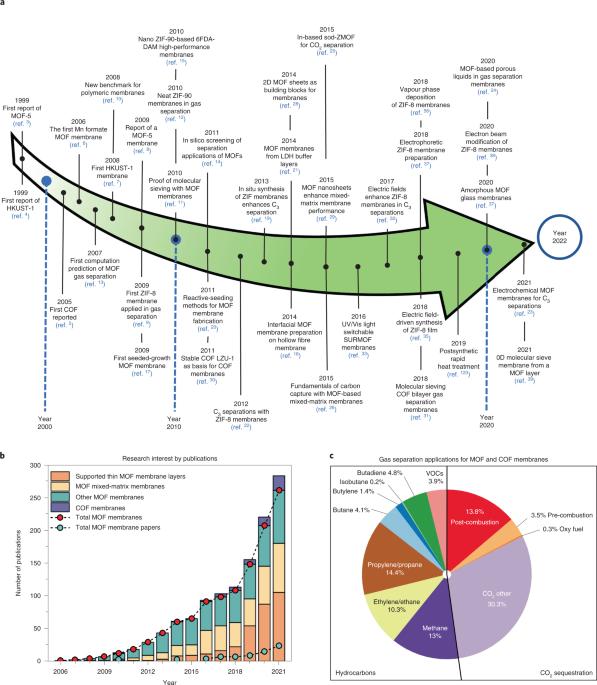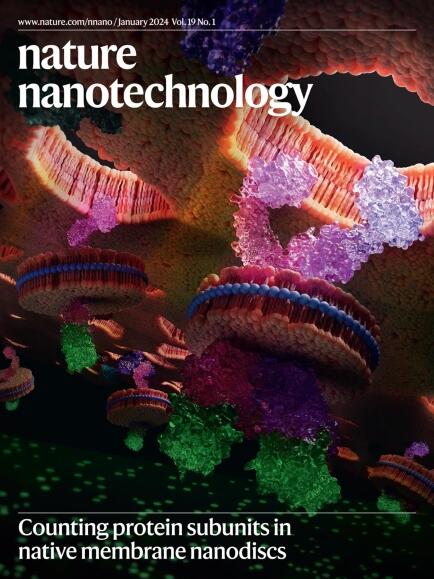Metal–organic frameworks and covalent organic frameworks as disruptive membrane materials for energy-efficient gas separation
IF 34.9
1区 材料科学
Q1 MATERIALS SCIENCE, MULTIDISCIPLINARY
引用次数: 90
Abstract
In this Review we survey the molecular sieving behaviour of metal–organic framework (MOF) and covalent organic framework (COF) membranes, which is different from that of classical zeolite membranes. The nature of MOFs as inorganic–organic hybrid materials and COFs as purely organic materials is powerful and disruptive for the field of gas separation membranes. The possibility of growing neat MOFs and COFs on membrane supports, while also allowing successful blending into polymer–filler composites, has a huge advantage over classical zeolite molecular sieves. MOFs and COFs allow synthetic access to more than 100,000 different structures and tailor-made molecular gates. Additionally, soft evacuation below 100 °C is often enough to achieve pore activation. Therefore, a huge number of synthetic methods for supported MOF and COF membrane thin films, such as solvothermal synthesis, seed-mediated growth and counterdiffusion, exist. Among them, methods with high scale-up potential, for example, layer-by-layer dip- and spray-coating, chemical and physical vapour deposition, and electrochemical methods. Additionally, physical methods have been developed that involve external stimuli, such as electric fields and light. A particularly important point is their ability to react to stimuli, which has allowed the ‘drawbacks’ of the non-ideality of the molecular sieving properties to be exploited in a completely novel research direction. Controllable gas transport through membrane films is a next-level property of MOFs and COFs, leading towards adaptive process deviation. MOF and COF particles are highly compatible with polymers, which allows for mixed-matrix membranes. However, these membranes are not simple MOF–polymer blends, as they require improved polymer–filler interactions, such as cross-linking or surface functionalization. This critical Review discusses the molecular sieving behaviour of metal–organic framework and covalent organic framework membranes as thin supported layers and mixed-matrix membranes. This behaviour is different from that of classical zeolite membranes.

金属有机框架和共价有机框架作为高能效气体分离的破坏性膜材料
在这篇综述中,我们研究了金属有机框架(MOF)和共价有机框架(COF)膜的分子筛分行为,这与传统的沸石膜不同。MOF 作为无机-有机混合材料,COF 作为纯有机材料,其性质对气体分离膜领域具有强大的颠覆性影响。与传统的沸石分子筛相比,MOFs 和 COFs 可以在膜支持物上生长,同时还可以成功地与聚合物-填料复合材料混合。与传统的沸石分子筛相比,MOFs 和 COFs 具有巨大的优势。MOFs 和 COFs 允许合成超过 100,000 种不同的结构和定制的分子门。此外,低于 100 °C 的软排空通常足以实现孔活化。因此,存在着大量用于支撑 MOF 和 COF 膜薄膜的合成方法,如溶解热合成、种子介导生长和反扩散。其中,逐层浸涂和喷涂法、化学和物理气相沉积法以及电化学法等方法具有很高的放大潜力。此外,还开发了涉及外部刺激(如电场和光线)的物理方法。特别重要的一点是它们对刺激的反应能力,这使得分子筛分特性非理想性的 "缺点 "在一个全新的研究方向上得到了利用。膜薄膜的可控气体传输是 MOFs 和 COFs 的下一级特性,可实现自适应过程偏差。MOF 和 COF 颗粒与聚合物高度兼容,因此可以制成混合基质膜。然而,这些膜并不是简单的 MOF-聚合物混合物,因为它们需要改进聚合物-填料之间的相互作用,如交联或表面功能化。这篇重要综述讨论了金属有机框架和共价有机框架膜作为薄支撑层和混合基质膜的分子筛分行为。这种行为不同于传统的沸石膜。
本文章由计算机程序翻译,如有差异,请以英文原文为准。
求助全文
约1分钟内获得全文
求助全文
来源期刊

Nature nanotechnology
工程技术-材料科学:综合
CiteScore
59.70
自引率
0.80%
发文量
196
审稿时长
4-8 weeks
期刊介绍:
Nature Nanotechnology is a prestigious journal that publishes high-quality papers in various areas of nanoscience and nanotechnology. The journal focuses on the design, characterization, and production of structures, devices, and systems that manipulate and control materials at atomic, molecular, and macromolecular scales. It encompasses both bottom-up and top-down approaches, as well as their combinations.
Furthermore, Nature Nanotechnology fosters the exchange of ideas among researchers from diverse disciplines such as chemistry, physics, material science, biomedical research, engineering, and more. It promotes collaboration at the forefront of this multidisciplinary field. The journal covers a wide range of topics, from fundamental research in physics, chemistry, and biology, including computational work and simulations, to the development of innovative devices and technologies for various industrial sectors such as information technology, medicine, manufacturing, high-performance materials, energy, and environmental technologies. It includes coverage of organic, inorganic, and hybrid materials.
 求助内容:
求助内容: 应助结果提醒方式:
应助结果提醒方式:


